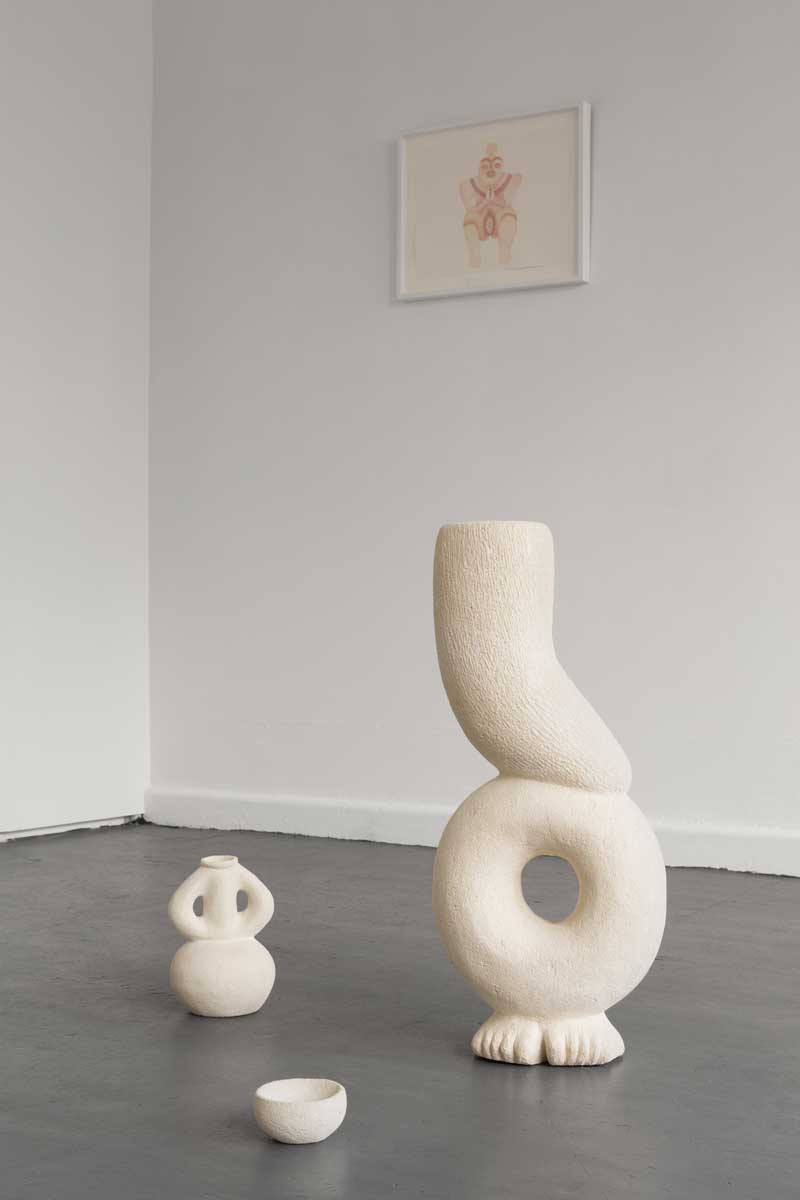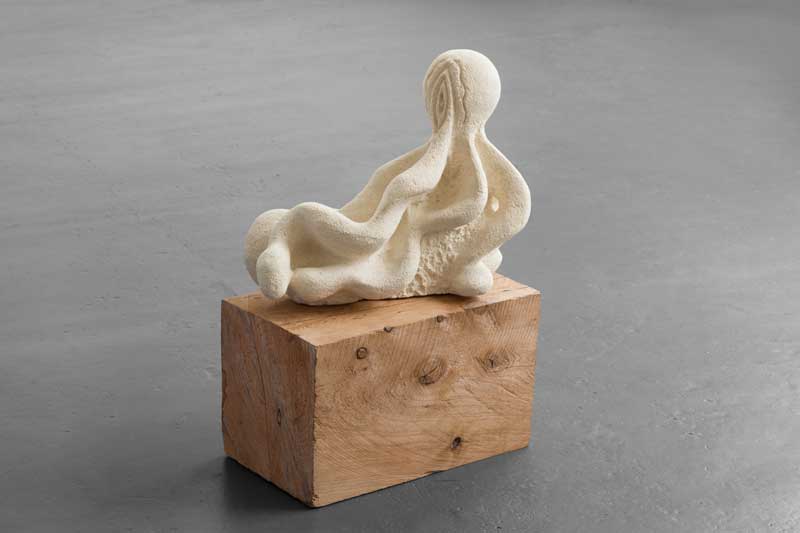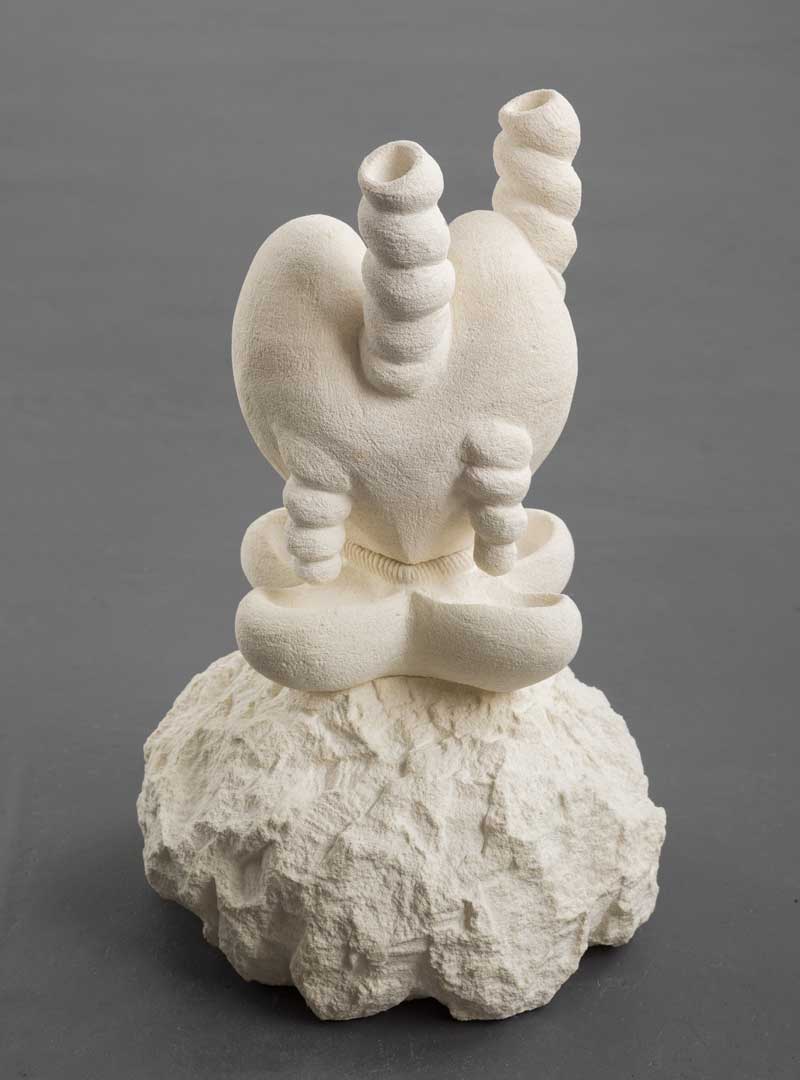
Some of the oldest recorded ceramics are carved from limestone, a soft stone recognised for its ability to be shaped, shed, smoothed over. Figures with heavy breasts and wide hips, what some believed to be sacred symbols of fertility, have been found carved from this substance. Due to its deeply absorbent and highly porous qualities, limestone is not recommended to hold water. It is a sedimentary rock, meaning that it is formed by the accumulation of geological and biological particles deep underwater. Often broken down to be repurposed in concrete, toothpaste or house paint, in the contemporary world we absorb it unknowingly. Encountering the limestone sculptures of Melbourne-based artist Noriko Nakamura recalls both these origins, the sacred and the everyday, from the humble and economically-titled Bowl (2019) to the many tentacled and mysterious form Becoming love’s expression (2019).

Limestone, gouache and human hair are the materials through which Noriko realised her exhibition The force that the warrior adopts during the evolution of the pale pink rose at CAVES in Melbourne. It marked CAVES first exhibition in their new space – a lofty, light- filled room, less cave-like than their former space – as well as Noriko’s first exhibition since becoming a mother. Noriko’s limestone sculptures form a tableau on the floor of the space, watched over by a series of four paintings of Dogū (土偶). Dogū are clay figures that combine animal and human qualities that are dated to the Jōmon period, in prehistoric Japan. In Noriko’s paintings these humanoids read as symbols of fertility. In one a squatting figure reveals a face peering out of an opened vulva, the figure’s hands peacefully clasped in prayer position.
In another painting titled Caesarean birth (2019) a gaping eye-shaped opening evokes both a vulva and a window into the reproductive organs. This painting takes on particular resonance when considered beside Noriko’s contribution to the West Space fundraising exhibition, The Process of Making, which was a photograph of the artist in the process of giving birth via c-section. In this photograph, a hospital-standard sheet of blue plastic curtains off the lower half of her body, behind which a cluster of medical practitioners appear to in the process of extracting the baby, while the artist looks directly at the camera. In this moment the experience of birth is twofold, as both the baby and the mother are born.
.jpg)
We don’t speak about birth, especially not caesarean birth, Norkio tells me. Silvia Federici has done important work in tracing how women became estranged and alienated from birth. Specifically, the Marxist feminist scholar has focused on how the social violence of early capitalism denied women control over their own bodies, severing them from traditional knowledge systems pertaining to reproductive health. As a result, in our contemporary moment of late capitalism, the experience of birth is paradoxically both singular and universal, shared and solitarily, and sometimes shameful.
During the tea ceremony held last Saturday, a small audience of adults and toddlers gathered. The tea ceremony was important to Noriko as an offering for the audience, encapsulating how she thinks of motherhood as a gesture for offering. (“All welcome” the invitation insisted.) The ceremony was performed by Yuka Mikayama with ritualised precision. It took place amongst the sculptures, which became supports for the various implements involved in the making of the tea, the matcha whisk nestled inside of Milking my heart (2019), the tea canister disappearing inside of The child (2019). Water pooled underneath the sculptural vessel that collected the remnants of matcha tea and hot water. The permeability of the stone acted as a reminder of how the boundaries of the body are let down during birth and post partum. Blood flows, fluids leak, colostrum and milk drip out.

The pregnant and birthing body is not orderly, and the pregnant body in particular is a site of evolutionary conflict and parasitic relations. The fleshy interdependence between mother and baby is a theme that the artist and academic Fayen D’Evie ruminates on in her essay Mother-Hooded which accompanies the exhibition. Mircochimerism is the name given to the common phenomenon of fetal cells escaping the uterus and becoming implanted in the organs of the mother, making her quite literally a chimera. The force that the warrior adopts during the evolution of the pale pink rose entangles the sacred and the everyday until there is no space between them at all.












